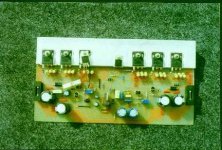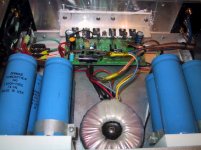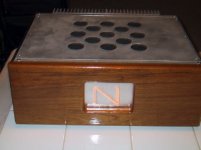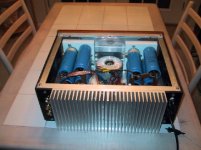Hai Anthony,
Did you say 16 output devices? That is 8 per bank? Will the voltage still be +-70volts? I think it should because according to our private dialogue, the reason I had problems with my earlier N-channel amp was that the voltage was too high at +-84volts.
Is there a way of increasing the available drive current from the Driver Mosfet (IRF610) so that the additive capacitance can be driven with relative ease.
Hai All,
The sound of the N-channel amp is remarkably detailed. The mids are particularly outstanding - most natural, articulate and detailed. Yes the bass is tuneful. The Highs could be improved. I have just emailed Anthony on this aspect and sought his opinion on a suggestion that I have made. Waiting for his response. The only amp that I have heard that is better than the N-channel in the Bass region, and yes overall sonically, is Stochino's Ultra Fast Amplifier. Yet in the midband, the N-channel is slightly more musical than the analytical nature of the Stochino amp.
I herein attach a rather crude image of the PCB that I have made for the N-channel amp. The PCB is hand-painted, etched and hand-drilled. Those of you interested can make your own tracks with the aid of some software and use this image as a guide. In order to give an idea of the component overlay, I re-post a photo of a populated PCB. I have emailed these images to Anthony. So soon he should be selling updated PCBs for the benefit of those who can't/won't fabricate their own.
Did you say 16 output devices? That is 8 per bank? Will the voltage still be +-70volts? I think it should because according to our private dialogue, the reason I had problems with my earlier N-channel amp was that the voltage was too high at +-84volts.
Is there a way of increasing the available drive current from the Driver Mosfet (IRF610) so that the additive capacitance can be driven with relative ease.
Hai All,
The sound of the N-channel amp is remarkably detailed. The mids are particularly outstanding - most natural, articulate and detailed. Yes the bass is tuneful. The Highs could be improved. I have just emailed Anthony on this aspect and sought his opinion on a suggestion that I have made. Waiting for his response. The only amp that I have heard that is better than the N-channel in the Bass region, and yes overall sonically, is Stochino's Ultra Fast Amplifier. Yet in the midband, the N-channel is slightly more musical than the analytical nature of the Stochino amp.
I herein attach a rather crude image of the PCB that I have made for the N-channel amp. The PCB is hand-painted, etched and hand-drilled. Those of you interested can make your own tracks with the aid of some software and use this image as a guide. In order to give an idea of the component overlay, I re-post a photo of a populated PCB. I have emailed these images to Anthony. So soon he should be selling updated PCBs for the benefit of those who can't/won't fabricate their own.
Attachments
Hi Sam
I have received you email and I have replied to it so you should have it by the time you see this response.
Concerning the number of o/p devices I was referring to driving 2 Ohms and yes at only +-70 volt rails...
The is no way I am aware of increasing the current drive in the driver splitted stage because the way the biasing is setup, it relys on the very bias current coming from the regulator. So once the bias has been set in the output stage, thats it...
Regards
Anthony
😉
I have received you email and I have replied to it so you should have it by the time you see this response.
Concerning the number of o/p devices I was referring to driving 2 Ohms and yes at only +-70 volt rails...
The is no way I am aware of increasing the current drive in the driver splitted stage because the way the biasing is setup, it relys on the very bias current coming from the regulator. So once the bias has been set in the output stage, thats it...
Regards
Anthony
😉
I have a N-channel amp that I built about a year ago. It got hit by a power surge that destroyed the output devices. I replaced the O/P devices and it now longer is blowing the fuses but I have 70 volts DC on the speaker output. Is this normal to have rail voltage on the output? Never measured it before the surge so I'm not sure if it was always there. Thanks in advance for the help.
Chad
Chad
Chad, it seems some other active device before the mosfets blew also. Often when the output devices blow, the drivers of those outputs blow too.🙁
Samuel, hand painting traces on the circuit boards sure makes things a lot simpler. 🙂
Samuel, hand painting traces on the circuit boards sure makes things a lot simpler. 🙂
Chad...
check the driver FET Q13 (iirc).
you'll probably find that it's driving the +ve rail outputs hard on, hence the 70V on the o/p.
if you replace that you should find it's ok - you might like to check the gate drive to the o/p FETs before you connect a load just in case something upstream ( like the lm317 ) is blown too.
you should see a low voltage on the gate with no signal ( just the bias voltage ) , any more than a few volts and I'd look further.
HTH
ray
check the driver FET Q13 (iirc).
you'll probably find that it's driving the +ve rail outputs hard on, hence the 70V on the o/p.
if you replace that you should find it's ok - you might like to check the gate drive to the o/p FETs before you connect a load just in case something upstream ( like the lm317 ) is blown too.
you should see a low voltage on the gate with no signal ( just the bias voltage ) , any more than a few volts and I'd look further.
HTH
ray
Thanks for all your help so far. I replaced every transistor, mosfet, and the voltage reg. I still have 70volts DC on the output. When I measure from the output ground to the signal in put ground I also get 70volts dc. Could it be a bad zener diode, feeding the voltage thru? Any and all help is welcome as I'm getting really frustrated. Thankyou all again
Chad
Chad
Chad, when I repair amps I check every semiconductor and all resistors in the output stage.
Also a blown input diff pair transistor will cause DC offset.
If that does not find it, I'll then check every resistor.
Eric.
Also a blown input diff pair transistor will cause DC offset.
If that does not find it, I'll then check every resistor.
Eric.
Thanks for the help! I think I found it. The ground coupling resistor (R28)for the signal ground was open. Once I replaced it the 70 volts DC went away on the output. I will try to rebias it tommorrow and see if it is working proprly again. Thanks Again.
Chad
Also thankyou to Anthony (www.aussieamplifiers.com) for his help, he answered everyone of my e-mails!
Chad
Also thankyou to Anthony (www.aussieamplifiers.com) for his help, he answered everyone of my e-mails!
Member
Joined 2002
Jason,
It has been a great amp for the last year, during a thunder storm we took a power surge that destroyed it and my Adcom 5500 luckily Adcom replaced the 5500 at no charge. Once I get the N-channel running again I will take some pics and post them.
Chad
It has been a great amp for the last year, during a thunder storm we took a power surge that destroyed it and my Adcom 5500 luckily Adcom replaced the 5500 at no charge. Once I get the N-channel running again I will take some pics and post them.
Chad
Member
Joined 2002
Mono or stereo?
All those big caps in there for just one module 😎 or is there a second one as well that we can't see?:
GP.
All those big caps in there for just one module 😎 or is there a second one as well that we can't see?:
GP.
It is mono I use it to drive a subwoofer. I bought the caps surplus for $5 each so I figured what the hell.




Member
Joined 2002
im only using 2 x 15,000 mf caps at 125v and they work awsome and im poweringa 4 ohm 15" subwoofer..
YEAH
YEAH
Member
Joined 2002
Please help...
I just finished my N-channel amp, had a long session to adjust bias, and then: TEST!!!
Hooked it up to my system, and started listening.
It sounded good, so I tested with a bit more power, but then, fireworks! (and one channel dead).
It seems that it started? with one or two of the gate resistors (R11 & R12) 470 Ohm. Then R8, R9, R14, R17, R19 turned to ash.
Was this due to oscillations? (did not hear any distortion).
What must I do to prevent it from happen again?
All is built as latest updates, exept slightly higher voltage, +/- 78V DC, from 2 x 800VA trafos, (2 x 55V AC, dual bridges pr, channel, 4 x 22 000 uF Rifas pr. channel).
Arne K
NORWAY

I just finished my N-channel amp, had a long session to adjust bias, and then: TEST!!!
Hooked it up to my system, and started listening.
It sounded good, so I tested with a bit more power, but then, fireworks! (and one channel dead).
It seems that it started? with one or two of the gate resistors (R11 & R12) 470 Ohm. Then R8, R9, R14, R17, R19 turned to ash.
Was this due to oscillations? (did not hear any distortion).
What must I do to prevent it from happen again?
All is built as latest updates, exept slightly higher voltage, +/- 78V DC, from 2 x 800VA trafos, (2 x 55V AC, dual bridges pr, channel, 4 x 22 000 uF Rifas pr. channel).
Arne K
NORWAY

- Status
- Not open for further replies.
- Home
- Amplifiers
- Solid State
- N-channel amp.



